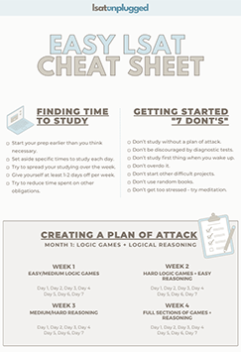I’ve talked in another article about how Sufficient Assumption (Justify) questions are generally based in formal logic. This time, I’m going a bit further with this idea.
I have analyzed every Sufficient Assumption question from LSAT PrepTests 19-58.
I found the vast majority of these questions fall into one of the following 6 categories:
- A restatement of the conclusion / argument
Conclusion / Argument: A –> B
Sufficient Assumption: A –> B
I know it sounds incredibly silly that LSAC would test this, but don’t laugh. As you can see below, this is clearly one of the most common patterns for Sufficient Assumption questions.
The correct answer may be worded much differently than the argument/conclusion in the stimulus, even though they cover the same concepts (using double-negatives, synonyms, etc.).
The correct answer may also be worded in more general terms than the argument/conclusion in the stimulus.
Examples (29 questions):
PrepTest 22 (June 1997 LSAT), Section 4, Question 2 – page 138 in 10 More
PrepTest 22 (June 1997 LSAT), Section 4, Question 5 – page 139 in 10 More
PrepTest 22 (June 1997 LSAT), Section 4, Question 13 – page 141 in 10 More
PrepTest 24 (December 1997 LSAT), Section 2, Question 21 – page 200 in 10 More
PrepTest 32 (October 2000 LSAT), Section 1, Question 5 – page 119 in Next 10
PrepTest 33 (December 2000 LSAT), Section 3, Question 21 – page 173 in Next 10
PrepTest 33 (December 2000 LSAT), Section 3, Question 23 – page 174 in Next 10
PrepTest 34 (June 2001 LSAT), Section 2, Question 2 – page 194 in Next 10
PrepTest 35 (October 2001 LSAT), Section 4, Question 19 – page 245 in Next 10
PrepTest 36 (December 2001 LSAT), Section 1, Question 22 – page 260 in Next 10
PrepTest 40 (June 2003 LSAT), Section 1, Question 19
PrepTest 40 (June 2003 LSAT), Section 1, Question 21
PrepTest 41 (October 2003 LSAT), Section 3, Question 22
PrepTest 42 (December 2003 LSAT), Section 2, Question 23
PrepTest 43 (June 2004 LSAT), Section 2, Question 18
PrepTest 43 (June 2004 LSAT), Section 3, Question 16
PrepTest 47 (October 2005 LSAT), Section 1, Question 12
PrepTest 49 (June 2006 LSAT), Section 2, Question 19
PrepTest 49 (June 2006 LSAT), Section 4, Question 18
PrepTest 50 (September 2006 LSAT), Section 4, Question 13
PrepTest 52 (September 2007 LSAT), Section 1, Question 17
PrepTest 52 (September 2007 LSAT), Section 1, Question 20
PrepTest 53 (December 2007 LSAT), Section 1, Question 20
PrepTest 54 (June 2008 LSAT), Section 2, Question 13
PrepTest 55 (October 2008 LSAT), Section 1, Question 4
PrepTest 55 (October 2008 LSAT), Section 3, Question 10
PrepTest 57 (June 2009 LSAT), Section 2, Question 12
PrepTest 57 (June 2009 LSAT), Section 3, Question 24
PrepTest 58 (September 2009 LSAT), Section 1, Question 12
- The contrapositive of the conclusion / argument
Conclusion / Argument: A –> B
Sufficient Assumption: NOT B –> NOT A
Examples (9 questions):
PrepTest 9 (October 1993 LSAT), Section 2, Question 23 – page 64 in 10 Actual
PrepTest 24 (December 1997 LSAT), Section 2, Question 24 – page 201 in 10 More
PrepTest 34 (June 2001 LSAT), Section 2, Question 10 – page 196 in Next 10
PrepTest 36 (December 2001 LSAT), Section 1, Question 26 – page 261 in Next 10
PrepTest 45 (December 2004 LSAT), Section 1, Question 21
PrepTest 46 (June 2005 LSAT), Section 3, Question 24
PrepTest 48 (December 2005 LSAT), Section 1, Question 25
PrepTest 49 (June 2006 LSAT), Section 2, Question 25
PrepTest 49 (June 2006 LSAT), Section 4, Question 22
- The sufficient condition of an argument
Evidence: A –> B –> C –> D
Conclusion: D
Sufficient Assumption #1: A
Sufficient Assumption #2: B
Sufficient Assumption #3: C
Examples:
PrepTest 35 (October 2001 LSAT), Section 1, Question 20 – page 225 in Next 10
PrepTest 36 (December 2001), Section 1, Question 18 – page 259 in Next 10
- The sufficient condition of a argument’s contrapositive
Evidence: A –> B –> C –> D
Contrapositive: NOT D –> NOT C –> NOT B –> NOT A
Conclusion: NOT A
Sufficient Assumption #1: NOT D
Sufficient Assumption #2: NOT C
Sufficient Assumption #3: NOT B
Examples:
PrepTest 23 (October 1997 LSAT), Section 3, Question 14 – page 167 in 10 More
PrepTest 44 (October 2004 LSAT), Section 4, Question 26
- The linkage of two pieces of evidence to form a chain that proves the conclusion true
Evidence #1: A –> B
Evidence #2: C –> D
Conclusion: A –> D
Sufficient Assumption #1: B –> C
Sufficient Assumption #2: NOT C –> NOT B
Examples:
PrepTest 46 (June 2005 LSAT), Section 2, Question 23
PrepTest 48 (December 2005 LSAT), Section 4, Question 21
PrepTest 58 (September 2009 LSAT), Section 1, Question 25
PrepTest 58 (September 2009 LSAT), Section 4, Question 19
6A. The linkage of the conclusion’s sufficient condition with the evidence’s sufficient condition so the former requires (or falls within) the latter.
(This can only be done after making the necessary conditions of the evidence and conclusion identical.)
Evidence: A –> B
Conclusion: C –> B
Sufficient Assumption #1: C –> A
Sufficient Assumption #2: NOT A –> NOT C
Contrapositively…
6B. The linkage of the evidence’s necessary condition with the conclusion’s necessary condition so the former requires (or falls within) the latter.
(This can only be done after making the sufficient conditions of the evidence and conclusion identical.)
Evidence: D –> E
Conclusion: D –> F
Sufficient Assumption #1: E –> F
Sufficient Assumption #2: NOT F –> NOT E
(You can often manipulate/rearrange evidence and conclusion for both 6A and 6B above by taking the contrapositive of the evidence, conclusion, or both.)
Examples (37 questions):
PrepTest 19 (June 1996 LSAT), Section 4, Question 11 – page 38 in 10 More
PrepTest 23 (October 1997 LSAT), Section 2, Question 5 – page 157 in 10 More
PrepTest 24 (December 1997 LSAT), Section 3, Question 10 – page 204 in 10 More
PrepTest 24 (December 1997 LSAT), Section 3, Question 19 – page 207 in 10 More
PrepTest 25 (June 1998 LSAT), Section 4, Question 18 – page 245 in 10 More
PrepTest 26 (September 1998 LSAT), Section 3, Question 21 – page 272 – in 10 More
PrepTest 28 (June 1999 LSAT), Section 1, Question 24 – page 328 – in 10 More
PrepTest 31 (June 2000 LSAT), Section 2, Question 10 – page 91 in Next 10
PrepTest 35 (October 2001 LSAT), Section 1, Question 22 – page 226 in Next 10
PrepTest 35 (October 2001 LSAT), Section 4, Question 14 – page 244 in Next 10
PrepTest 36 (December 2001 LSAT), Section 3, Question 12 – page 273 in Next 10
PrepTest 37 (June 2002 LSAT), Section 2, Question 5 – page 297 in Next 10
PrepTest 37 (June 2002 LSAT), Section 4, Question 9 – page 310 in Next 10
PrepTest 37 (June 2002 LSAT), Section 4, Question 20 – page 313 in Next 10
PrepTest 38 (October 2002 LSAT), Section 1, Question 1 – page 322 in Next 10
PrepTest 38 (October 2002 LSAT), Section 4, Question 16 – page 346 in Next 10
PrepTest 40 (June 2003 LSAT), Section 1, Question 8
PrepTest 40 (June 2003 LSAT), Section 3, Question 15
PrepTest 42 (December 2003 LSAT), Section 2, Question 19
PrepTest 44 (October 2004 LSAT), Section 2, Question 13
PrepTest 45 (December 2004 LSAT), Section 4, Question 22
PrepTest 46 (June 2005 LSAT), Section 2, Question 4
PrepTest 47 (October 2005 LSAT), Section 1, Question 9
PrepTest 47 (October 2005 LSAT), Section 3, Question 21
PrepTest 49 (June 2006 LSAT), Section 2, Question 7
PrepTest 50 (September 2006 LSAT), Section 2, Question 22
PrepTest 51 (December 2006 LSAT), Section 1, Question 16
June 2007 LSAT, Section 2, Question 6
PrepTest 52 (September 2007 LSAT), Section 3, Question 15
PrepTest 54 (June 2008 LSAT), Section 2, Question 26
PrepTest 54 (June 2008 LSAT), Section 4, Question 22
PrepTest 55 (October 2008 LSAT), Section 3, Question 21
PrepTest 56 (December 2008 LSAT), Section 3, Question 16
PrepTest 58 (September 2009 LSAT), Section 4, Question 19
PrepTest 58 (September 2009 LSAT), Section 4, Question 24
***
Some notes on understanding the information above:
I placed the categories above in order from least complex to most complex – not in order of how common they are, of course.
The number of variables in an argument’s stimulus / correct answer choice may not perfectly match the number of variables in the category templates I laid-out above (the abstracted versions of the argument types using the letters A, B, C, and D.).
After doing enough of these questions, you’ll get to the point where simply by reading the stimulus, you’ll often have a sense of which category you’re dealing with. If you can do this, you’ll often be able to pre-phrase (predict) the correct answer before even looking at the choices.
***
The questions categorized above do not include every single Sufficient Assumption question from PrepTests 19-58. They just include most Sufficient Assumption questions from these exams.
Sufficient Assumption questions not covered above from these exams tended to be less formal-logicky and/or unique in some way. They’re still worth looking at, of course.

